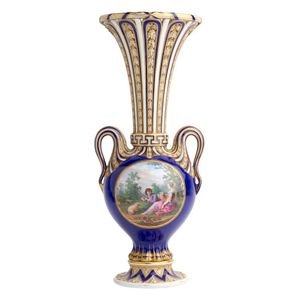Rare Sevres Porcelain Reticulated Vase, 1762
A rare Sevres porcelain reticulated vase (vase cornet), blue interlaced L mark with date letter K for 1762, painter's mark K for Charles Nicolas Dodin (fl 1754-1800+), the tall flared neck with a ribbon-tied reeded rim above flutes pierced with gilt ribbon-tied pendant oak leaves, within blue borders, above a greek-key band flanked by a pair of partially reticulated handles, the ovoid 'Bleu nouveau' body with a reserve painted in colours with a shepherd, shepherdess and sheep in a landscape in the manner of Boucher, the reverse with peaches, grapes and flowers, the circular foot moulded with zig zag and acanthus flowers, height 43.7 cm. Literature: Brunet, M and Preaud, T, 'Sevres: Des origines a nos jours', 1978, p.168, no.132. Other Notes: at the cusp of the rococo and neo-classicism this vase combines elements of both styles- the classical moulded Greek-key, oak leaves and ribbon tied motifs combined with the rococo scrolling terminals to the handles and the shaped base of the ovoid body. The Sevres Collections of the Duke of Bedford, Woburn Abbey, Bedfordshire has a vase of the same model and size, and similar vases of a smaller size in different colours can be found in the Philadelphia Museum of Art, Pennsylvania and the Worcester Art Museum, Massachusetts.
You must be a subscriber, and be logged in to view price and dealer details.
Subscribe Now to view actual auction price for this item
When you subscribe, you have the option of setting the currency in which to display prices to $Au, $US, $NZ or Stg.
This item has been sold, and the description, image and price are for reference purposes only.
- Manner of .... / Style of ..... - A cataloguing term where the item, in the opinion of the cataloguer is a work in the style of the artist, craftsman or designer, possibly of a later period.
- Oviform /ovoid - The outline loosely resembling the shape of an egg.
- Acanthus - A stylized leaf motif, one of the primary decorative elements of classical Greek and Roman architecture, derived from the genus of flowering plants in the family Acanthaceae, native to tropical and subtropical regions of the Mediterranean area. It is a common element in classical Greek and Roman design, and is often seen in Corinthian and Composite order columns and used as a decorative element in English, European and Australian furniture, particularly on the curve of a leg, and as decoration for a corbel.
- Oak - Native to Europe and England, oak has been used for joinery, furniture and building since the beginning of the medieval civilisation. It is a pale yellow in colour when freshly cut and darkens with age to a mid brown colour.
Oak as a furniture timber was superceded by walnut in the 17th century, and in the 18th century by mahogany,
Semi-fossilised bog oak is black in colour, and is found in peat bogs where the trees have fallen and been preserved from decay by the bog. It is used for jewellery and small carved trinkets.
Pollard oak is taken from an oak that has been regularly pollarded, that is the upper branches have been removed at the top of the trunk, result that new branches would appear, and over time the top would become ball-like. . When harvested and sawn, the timber displays a continuous surface of knotty circles. The timber was scarce and expensive and was used in more expensive pieces of furniture in the Regency and Victorian periods.
This item has been included into following indexes:
-
Sevres (France) and Sevres style, items
- house wares 265
- vases and urns 215
